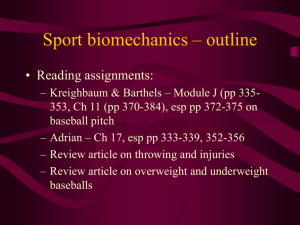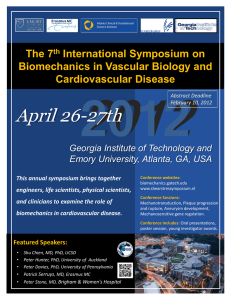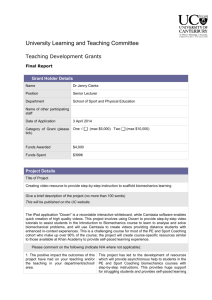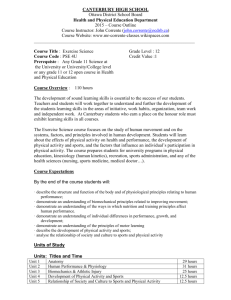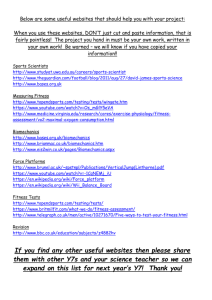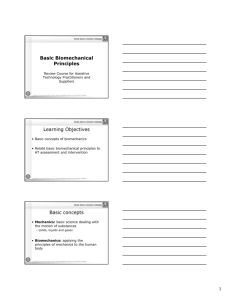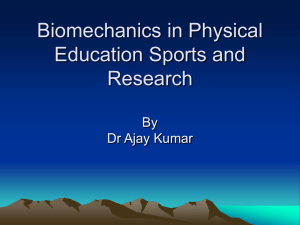Sport Biomechanics
advertisement
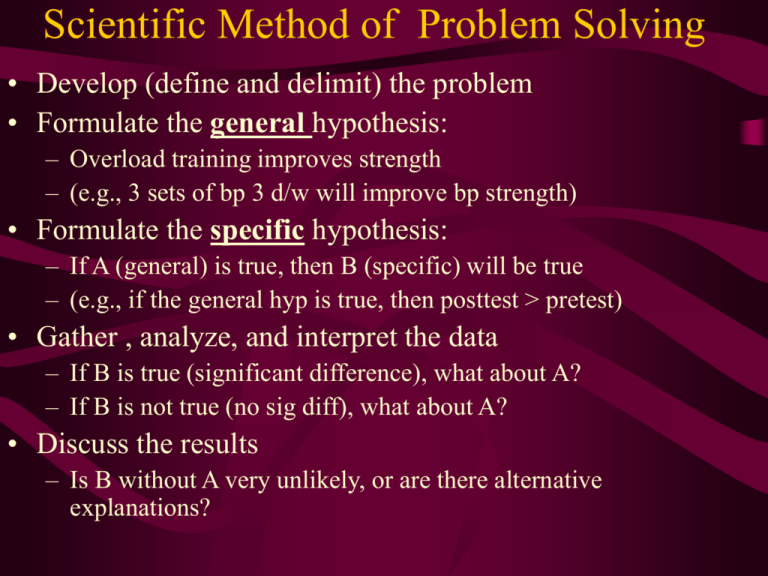
Scientific Method of Problem Solving • Develop (define and delimit) the problem • Formulate the general hypothesis: – Overload training improves strength – (e.g., 3 sets of bp 3 d/w will improve bp strength) • Formulate the specific hypothesis: – If A (general) is true, then B (specific) will be true – (e.g., if the general hyp is true, then posttest > pretest) • Gather , analyze, and interpret the data – If B is true (significant difference), what about A? – If B is not true (no sig diff), what about A? • Discuss the results – Is B without A very unlikely, or are there alternative explanations? Sport biomechanics – outline • Reading assignments: – Kreighbaum & Barthels – Module J (pp 335353, Ch 11 (pp 370-384), esp pp 372-375 on baseball pitch – Adrian – Ch 17, esp pp 333-339, Ch 18, esp 365-369 Biomechanical correlates of participation in sports: areas of interest and effort • Evaluate process – technique – optimize efficiency, or outcome • Injury potential/prevention • How to enhance acquisition of sport skills– motor learning • Design appropriate conditioning programs to enhance performance • Equipment Design and Selection – – – – – ground-foot interfaces protective equipment (pads, gloves, head gear) striking implements balls Sports playing surfaces Exercise and Sport Biom Prof Org • • • • • • • • • • • • • • American College of Sports Medicine International Society of Biomechanics in Sports Biomechanics academy of AAHPERD North American Society of Biomechanics International Association for Sports Surface Sciences International Society of Biomechanics American society of Biomechanics Canadian Society of Biomechanics European Society of Biomechanics Formosan Society of Biomechanics International Sports Engineering Association International Shoulder Group ISB Technical Group on the 3-D Analysis of Human Movement. European Society for Movement Analysis in Adults and Children Sport biomechanics journals • • • • • • • • • • • • • • Research quarterly for exercise and sport Medicine and science in sport and exercise Journal of applied biomechanics Sports biomechanics International journal of sport and health science Journal of sports sciences Sports engineering Pediatric exercise science Journal of orthpaedic and sport physical therapy Journal of biomechanics Journal of athletic training Journal of strength and conditioning research Journal of electromyographic kinesiology Sports medicine Throwlike and Pushlike Movement Patterns • Usual objectives of throw and push patterns • projection of objects for greatest horiz or vert dist – ex : javelin, discus, shotput • projection of objects for accuracy with speed a factor – ex: volleyball, tennis, racquetball, baseball pitch • Movement pattern terminology review • Throwing patterns are further defined as underarm, sidearm, or overarm Skills listed under each pattern differ because of constraints – ex: rules governing implement or ball, rules governing target. • Open and Closed chain movements • Open kinetic chain - sequential segmental action, end segment is free to move (e.g., baseball pitch) • Closed kinetic chain - simultaneous end segment movement, end segment meets with “considerable resistance “ (e.g., shot put) Common movement patterns Throwlike and Pushlike Movement Patterns • Characteristics of throw-like patterns – can be a strike or a kick – high end-point velocity is critical – sequential segmental action, object lags behind elbow and/or shoulder • Open kinetic link model - Figure J.1, p 338; J.2, p 339 • Linear motion of a point on a rotating segment: V = r • Sequencing segmental rotations - kinetic link principle – – – – system has a base and a free open end segmental masses progressively decrease an external torque is applied at the base to initiate the movement segmental rotational acceleration is timed sequentially • A model of an open kinetic link system - Fig J.4, p 343 • Throwlike movements performed while in the air - Fig J.5, p 345 Three-segment kinetic link model Threesegment model: (Fig j.2, p 339) Whip-like action of segmental system Three-segment model when airborne: Throwing motion (sequential) Segmental sequence when throwing Phases of pitching: 1. 2. 3. 4. Windup (a-k) Early Preparation (l-m) Late preparation (n-p) Release (r-u) From: Feltner, M. & Dapena, J. (1986) Dynamics of shoulder and elbow joints of the throwing arm during a baseball pitch. Int J Biomech 235-259. Javelin – similar To baseball pitch Shotput – some throw & some push American Sports Medicine Institute analyzes pitching (www.asmi.org) The kinetic chain illustrated in baseball pitch Poor technique can cause both injury and poor performance Throwlike and Pushlike Movements • Pushlike patterns - Simultaneous segmental actions – Objective is accuracy, or large motive force – Distal segments move simultaneously, resulting in rectilinear movement of distal segment – Four differences in throw and push. In throws: • distal segment “lags back”, segments move sequentially, object moves curvilinearly, wheel-axle movements (shoulder and hip rotation) involved • Movements lie on a throw-push continuum, the location depending on constraints of performer and object: – performer strength and skill – object mass, size, and shape Pushing Motions Development of throwing motion Developmental stages of throwing • Stage 1- ball thrown primarily with elbow extension – no rotation of thorax or arm • Stage 2 - Thoracic rotation accompanies backward motion of the arm. The throw is initiated by the arm swing forward. Some arm rotation as well as forearm extension at various times • Stage 3 - step is taken with same side foot to initiate throw • Stage 4 – step is taken with contralateral foot, thoracic rotation, arm rotation, elbow extension Side arm striking pattern: The baseball swing Stance Stride Lift front foot Bat begins moving forward Follow-through Ball-bat impact Swing Description of the baseball swing
